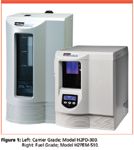In-House Generation of Hydrogen for Gas Chromatography
The Application Notebook
Hydrogen, commonly used as a carrier gas instead of Helium for gas chromatography (GC) can be supplied via cylinders or by the electrolysis of water using an in-house generator containing metallic electrodes or an ionomeric membrane. An in-house generator can provide a significant increase in safety and convenience with a reduction in operating costs.
Hydrogen, commonly used as a carrier gas instead of Helium for gas chromatography (GC) can be supplied via cylinders or by the electrolysis of water using an in-house generator containing metallic electrodes or an ionomeric membrane. An in-house generator can provide a significant increase in safety and convenience with a reduction in operating costs.
Since the availability of Helium has decreased, many chromatographers use Hydrogen instead of Helium as the carrier gas for GC. In addition, Hydrogen allows a lower separation temperature, increasing column life and reducing thermal decomposition of the analyte. While Hydrogen is frequently obtained from cylinders, in-house generation via the electrolysis of water is safer, more convenient, and less costly.

Figure 1
In House Generation of Hydrogen via the Electrolysis of Water
a) Using Metallic Electrodes
Hydrogen can be generated using metal electrodes and an electrolyte (e.g. 20 % NaOH). A typical system (Parker Balston Model H2PD-300 Hydrogen Generator) generates Hydrogen (99.99999+ % pure, oxygen <0.01 ppm and moisture <0.01 ppm) at flow rates up to 300 mL/min and a maximum pressure of 60 psi. The cathode is a bundle of palladium tubes; allowing hydrogen to pass through while impurities are excluded (hydrogen from generators with metal electrodes and a desiccant to dry hydrogen contain 12 ppm of O2 and N2).
b) Ionomeric Proton Exchange Membranes
Nafion®, a proton exchange membrane (PEM) used in fuel cells creates a current (and water) from hydrogen and oxygen. When an appropriate potential is applied to water, hydrogen and oxygen are formed. A hydrogen generator based on PEM technology (Parker Model H2PEM-510 Hydrogen Gas Generator) generates 99.9995% hydrogen at flow rates up to 510 mL/min and a maximum pressure of 100 psi. Purity of 99.9995% is suitable as a detector fuel gas.
Benefits of in-house Generation of Hydrogen
Safety
Since in-house generators deliver Hydrogen at low pressure, a leak presents a minimal hazard. If an overpressure or a pressure loss occurs, production is immediately stopped and an alert is sent to an external controller or alarm. They are CE compliant and conform to NFPA, OSHA 1910.103 and IEC, CSA, UL and cUL standards. In contrast, a cylinder contains hydrogen at high pressure which could enter the laboratory if a leak occurred, potentially leading to asphyxiation and/or an explosion.
Convenience
When an in-house generator is employed, hydrogen is provided on-demand. In contrast, when a cylinder is used, the operator must maintain replacements. If replacement cylinders are stored in a remote (outdoor) location for safety reasons, qualified personnel may be required for replacement.
Eliminate Contamination
When an in-house generator is employed, a permanent connection to the chromatograph is made. When a cylinder is replaced, the connection must be broken; potentially introducing contaminants with a deleterious effect on the column and/or the separation.
Cost
The power consumption for a generator and maintenance/replacement costs are quite low and the payback period of an in-house generator is usually one year.
Conclusions
Hydrogen is commonly substituted for Helium in GC and an in-house system increases safety and convenience while decreasing cost. An in-house generator creates a steady stream of low pressure gas, minimizing safety issues. The generator is more convenient, requires essentially no maintenance and minimizes the possibility of system contamination.
Parker Hannifin Corporation
242 Neck Road, Haverhill MA 01835-0723
tel. (800)343-4048, fax (978)556-7510
Website: www.labgasgenerators.com

The Benefits of Custom Bonded Silica
April 1st 2025Not all chromatography resins are created equal. Off-the-shelf chromatography resins might not always meet the rigorous purification requirements of biopharmaceutical manufacturing. Custom bonded silica from Grace can address a wide range of separation challenges, leading to real performance improvements. Discover more about the latest innovations in chromatography silica from Grace, including VYDAC® and DAVISIL®.
5 Things to Consider When Selecting a Chromatography Silica
April 1st 2025Particularly in the pharmaceutical industry, drug purity isn’t just a goal – it’s essential for achieving safety, stability and efficacy. However, purification is easier said than done, especially with challenging molecules like DNA and RNA “oligonucleotides,” due in large part to their diversity and the range of impurities that can be generated during production. Enter DAVISIL® chromatographic silica, with a wide range of pore diameters and particle sizes to meet your specific application, performance and sustainability requirements. Before you choose the chromatography resin for your next purification application, take a look at these 5 considerations.
Automating Protein Purification: Efficiency, Yield, and Reproducibility
March 27th 2025Recent advancements in automated protein purification stress the importance of efficiency, scalability, and yield consistency. This eBook compares different purification platforms, highlighting their impact on downstream applications and demonstrating how automation enhances throughput and process control.
MilliporeSigma: Ultrapure Water for Sensitive LC-MS Analysis of Pesticides
March 25th 2025The aim of the study was to illustrate the efficiency of Milli-Q® water purification systems in eliminating pesticides from tap water, thereby producing and delivering reliable and consistent-quality ultrapure water suitable for pesticides analysis















